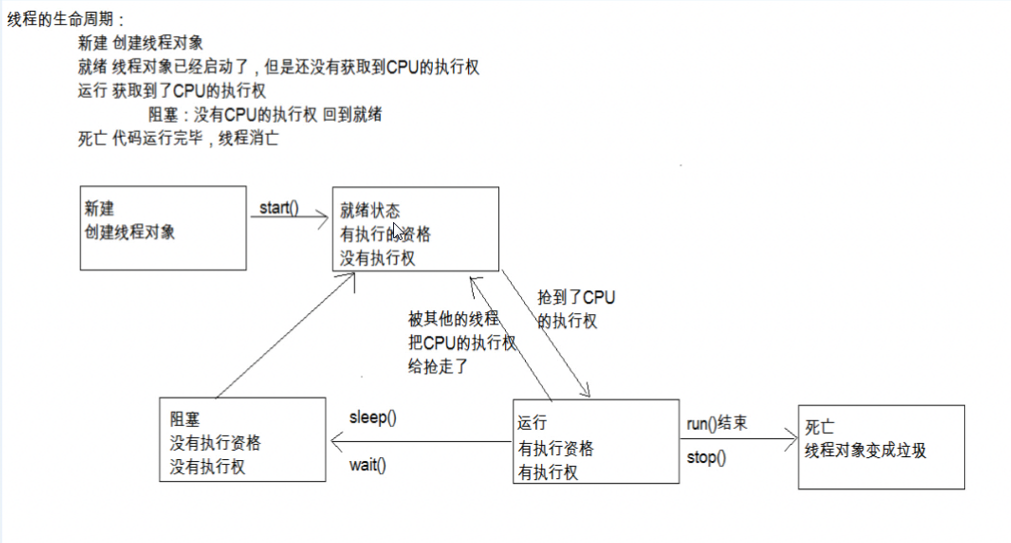1、互斥锁(ReentrantLock):
互斥锁是JDK1.5的新特性,目的就是为了替换同步代码块(同步锁),使进程间的通信更加简洁
下面重写我们上一篇的三个及三个以上线程间的通信:
思路:
- ReentrantLock类的lock() 和unlock() 方法可以替换synchronized同步代码块(基本上就是可以直接替换)
- newCondition() 方法返回一个实现了Condition接口的对象,再用await() 方法使之等待,用signal() 唤醒下一个线程,这两个方法就相当于Object的wait() 和notify() 方法(每一个线程都要创建一个实现了Condition接口的对象,一开一关)
package cn.xinhua;
import java.util.concurrent.locks.Condition;
import java.util.concurrent.locks.ReentrantLock;
public class ThreadTest {
public static void main(String[] args) {
Print p = new Print();
Thread t1 = new Thread() {
public void run() {
for (int i = 0; i < 1000; i++) {
try {
p.print1();
} catch (InterruptedException e) {
// TODO Auto-generated catch block
e.printStackTrace();
}
}
}
};
Thread t2 = new Thread() {
public void run() {
for (int i = 0; i < 1000; i++) {
try {
p.print2();
} catch (InterruptedException e) {
// TODO Auto-generated catch block
e.printStackTrace();
}
}
}
};
Thread t3 = new Thread() {
public void run() {
for (int i = 0; i < 1000; i++) {
try {
p.print3();
} catch (InterruptedException e) {
// TODO Auto-generated catch block
e.printStackTrace();
}
}
}
};
t1.start();
t2.start();
t3.start();
}
}
// 互斥锁
class Print extends Thread {
final private ReentrantLock r = new ReentrantLock();
final private Condition c1 = r.newCondition();
final private Condition c2 = r.newCondition();
final private Condition c3 = r.newCondition();
final Object obj = new Object();
private int target = 1;
public void print1() throws InterruptedException {
r.lock();
if (target != 1) {
c1.await();
}
System.out.print("我");
System.out.print("是");
System.out.print("吴");
System.out.print("彦");
System.out.print("祖");
System.out.println();
target = 2;
c2.signal();
r.unlock();
}
public void print2() throws InterruptedException {
r.lock();
if (target != 2) {
c2.await();
}
System.out.print("你");
System.out.print("要");
System.out.print("相");
System.out.print("信");
System.out.print("我");
System.out.println();
target = 3;
c3.signal();
r.unlock();
}
public void print3() throws InterruptedException {
r.lock();
if (target != 3) {
c3.await();
}
System.out.print("不");
System.out.print("信");
System.out.print("我");
System.out.print("拉");
System.out.print("倒");
System.out.println();
target = 1;
c1.signal();
r.unlock();
}
}
输出:
我是吴彦祖
你要相信我
不信我拉倒
我是吴彦祖
你要相信我
不信我拉倒
我是吴彦祖
你要相信我
不信我拉倒
我是吴彦祖
你要相信我
不信我拉倒
。。。
2、线程组:
线程组就是利用Thread的一个构造方法,将我们创建的线程统一放到一个线程组里方便操作
- 创建线程组对象
- 用构造方法创建Thread对象并将线程放到线程组里
1. 创建线程组对象
ThreadGroup tg = new ThreadGroup("我是线程组");
2. 用构造方法创建Thread对象并将线程放到线程组里
Thread t1 = new Thread(tg,"吴彦祖")
Thread t2 = new Thread(tg,"周杰伦")
Thread t3 = new Thread(tg,"林宥嘉")
System.out.println(t1.getName());
System.out.println(t2.getName());
System.out.println(t3.getThreadGroup().getName());
输出:
吴彦祖
周杰伦
我是线程组
3、线程的生命周期:

4、线程池:
- 创建线程池
- 将线程放进线程池里并执行
- 关闭线程池
1. 创建线程池
ExecutorService pool = Executors.newFixedThreadPool(2);
2. 将线程放进线程池里并执行
pool.submit(new MyRunable);
pool.submit(new MyRunable);
3. 关闭线程池
pool.shutdown();